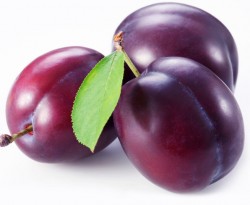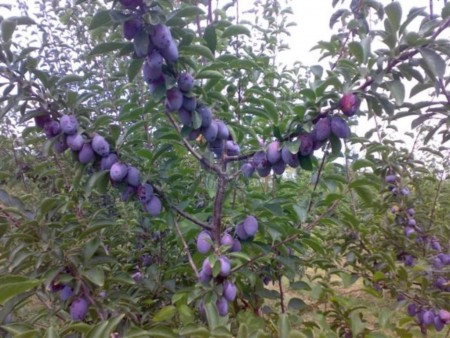There are more than 1,000 varieties of plums around the world. They all differ in winter hardiness, yield, taste, size and weight of the fruit. Given such diversity, it is impossible to say exactly how much one plum weighs. We have to focus on averages.
How many plums are there in 1 kg, in 100 grams?
All weight tables indicate that one plum weighs 30 grams. But apparently these tables were compiled a long time ago, when there were no large-fruited varieties of this crop.Thanks to the tireless work of breeders, plum trees now grow in our gardens, the fruits of which weigh 60-70 grams. This is already the mass of a small apple.
But the old varieties have not gone away and small creams of 30 grams grow on them. As a result, the average weight of plums ranges from 20 to 60 grams.
Thus it turns out that:
- On average, one plum weighs approximately 35 - 45 grams.
- 100 grams will contain 2 large or 3 small plums.
- In 1 kg. from 20 to 30 plums, depending on the size of the fruit.
Many people are interested in how much a plum pit weighs. It must be said that the bones are very light and this indicator can be neglected. A plum without a pit weighs almost the same as one with a pit.
- The weight of a plum pit is only 6-7% of the weight of the fruit.
How many calories are in plums
100 grams of plums = 42 kcal.
Considering that plum fruits vary significantly in size, we can say:
- 1 large plum contains 18 - 21 kcal.
- 1 small cream contains 11 - 14 kcal.
Different varieties of this crop have approximately the same caloric content, but if anyone is interested in how many calories are in a blue or black plum, then this can be seen in the table below.
Calorie table for different varieties of plums, per 100 grams of product:
| Varieties | How many kcal are in 100 g of product |
| In yellow plums | 43,5 |
| In blue plums | 43 |
| In red plums | 46 |
| In black plums | 45,2 |
| In prunes | 231,0 |
The nutritional value
Per 100 g of product
- Proteins - 0.8 g
- Fats - 0.3 g
- Carbohydrates - 9.6 g
- Organic acids - about 1 gram
- Mono and disaccharides - 9.45 g
- Dietary fiber - 1.51 g
- Water - 86.29 g
How many plums can you eat per day?
This fruit is very useful and healthy people can eat it without restrictions. The fruits contain a lot of vitamins A, B, C, and E, as well as proteins, carbohydrates and organic acids that speed up metabolism.Despite all the richness of nutrients, this product contains few calories, which is important for people who want to lose weight, but who like to pamper themselves with something tasty.
According to nutritionists, the daily intake of fruit for an adult is 200-300 g.
How many years after planting does a plum tree begin to bear fruit?
The beginning of plum fruiting largely depends on the variety of seedling and its precociousness. If you decide to grow a tree from a seed, then under the most favorable conditions, you will taste the first harvest only after 5-7 years.
When purchasing a seedling from a nursery, you can expect fruiting in 3-4 years. To speed up fruiting, the crown of the seedling should be formed with a limited number of skeletal branches. Simply put, the fewer branches there are on a seedling, the sooner the tree will begin to bear fruit. At the same time, do not forget to provide it with adequate nutrition and timely watering.
A plum tree bears fruit for an average of 20 years. After this period, the branches begin to dry out and this means that you need to take care of changing the tree.
How many plum fruits can be collected from one tree, from 1 hectare.
This crop is one of the most productive of all stone fruits. Under favorable weather conditions and a high level of agricultural technology, up to 100 kg can be harvested from one tree. fruits
The most productive variety is recognized as Caucasian Hungarian, the yield of which reaches 258.5 c/ha. Other varieties are also quite productive and allow you to harvest 200 - 246 c/ha. delicious fruits. Of course, the yield varies from year to year; it is influenced by both external factors and the biological characteristics of the varieties.





 CUCUMBERS NEVER GET SICK, I'VE BEEN USING ONLY THIS FOR 40 YEARS! I SHARE A SECRET WITH YOU, CUCUMBERS ARE LIKE THE PICTURE!
CUCUMBERS NEVER GET SICK, I'VE BEEN USING ONLY THIS FOR 40 YEARS! I SHARE A SECRET WITH YOU, CUCUMBERS ARE LIKE THE PICTURE! You can dig a bucket of potatoes from each bush. Do you think these are fairy tales? Watch the video
You can dig a bucket of potatoes from each bush. Do you think these are fairy tales? Watch the video
 How our fellow gardeners work in Korea. There is a lot to learn and just fun to watch.
How our fellow gardeners work in Korea. There is a lot to learn and just fun to watch. Eye trainer. The author claims that with daily viewing, vision is restored. They don't charge money for views.
Eye trainer. The author claims that with daily viewing, vision is restored. They don't charge money for views. A 3-ingredient cake recipe in 30 minutes is better than Napoleon. Simple and very tasty.
A 3-ingredient cake recipe in 30 minutes is better than Napoleon. Simple and very tasty. Therapeutic exercises for cervical osteochondrosis. A complete set of exercises.
Therapeutic exercises for cervical osteochondrosis. A complete set of exercises. Which indoor plants match your zodiac sign?
Which indoor plants match your zodiac sign? What about them? Excursion to German dachas.
What about them? Excursion to German dachas.